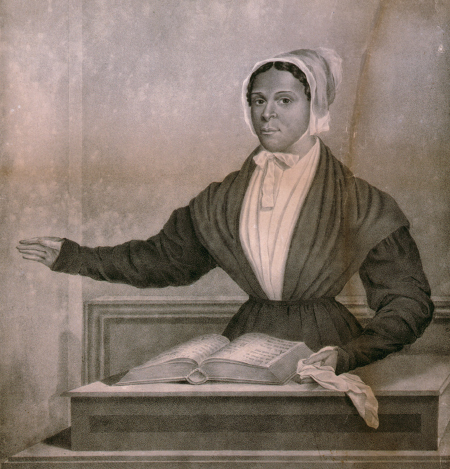America’s History: Printed Page 275
America: A Concise History: Printed Page 250
America’s History: Value Edition: Printed Page 241
Women’s New Religious Roles
The upsurge in religious enthusiasm allowed women to demonstrate their piety and even to found new sects. Mother Ann Lee organized the Shakers in Britain and in 1774 migrated to America, where she attracted numerous recruits; by the 1820s, Shaker communities dotted the American countryside from New Hampshire to Indiana. Jemima Wilkinson, a young Quaker woman in Rhode Island, found inspiration by reading George Whitefield’s sermons. After experiencing a vision that she had died and been reincarnated as Christ, Wilkinson declared herself the “Publick Universal Friend,” dressed in masculine attire, and preached a new gospel. Her teachings blended the Calvinist warning of “a lost and guilty, gossiping, dying World’’ with Quaker-inspired plain dress, pacifism, and abolitionism. Wilkinson’s charisma initially won scores of converts, but her radical lifestyle and ambiguous gender aroused hostility, and her sect dwindled away.

A Growing Public Presence Female-led sects had far less impact than thousands of women in mainstream churches. For example, women in New Hampshire churches managed more than fifty local “cent” societies to raise funds for the Society for Promoting Christian Knowledge, New York City women founded the Society for the Relief of Poor Widows, and young Quaker women in Philadelphia ran the Society for the Free Instruction of African Females.
Women took charge of religious and charitable enterprises because of their exclusion from other public roles and because of their numbers. After 1800, more than 70 percent of the members of New England Congregational churches were women. The predominance of women prompted Congregational ministers to end traditional gender-segregated prayer meetings, and evangelical Methodist and Baptist preachers actively promoted mixed-sex praying. “Our prayer meetings have been one of the greatest means of the conversion of souls,” a minister in central New York reported in the 1820s, “especially those in which brothers and sisters have prayed together.”
Far from leading to sexual promiscuity, as critics feared, mixing men and women in religious activities promoted greater self-discipline. Believing in female virtue, young women and the men who courted them postponed sexual intercourse until after marriage — previously a much rarer form of self-restraint. In Hingham, Massachusetts, and many other New England towns, more than 30 percent of the women who married between 1750 and 1800 bore a child within eight months of their wedding day; by the 1820s, the rate had dropped to 15 percent.
As women claimed spiritual authority, men tried to curb their power. In both the North and the South, evangelical Baptist churches that had once advocated spiritual equality now prevented women from voting on church matters or offering public testimonies of faith. Testimonies by women, one layman declared, were “directly opposite to the apostolic command in [Corinthians] xiv, 34, 35, ‘Let your women learn to keep silence in the churches.’” Another man claimed, “Women have a different calling. That they be chaste, keepers at home is the Apostle’s direction.” Such injunctions merely changed the focus of women’s religious activism. Embracing the idea of republican motherhood, Christian women throughout the United States founded maternal associations to encourage proper child rearing. By the 1820s, Mother’s Magazine and other newsletters, widely read in hundreds of small towns and villages, were giving women a sense of shared identity and purpose.
Religious activism also advanced female education, as churches sponsored academies where girls from the middling classes received intellectual and moral instruction. Emma Willard, the first American advocate of higher education for women, opened the Middlebury Female Seminary in Vermont in 1814 and later founded girls’ academies in Waterford and Troy, New York. Beginning in the 1820s, women educated in these seminaries and academies displaced men as public-school teachers, in part because they accepted lower pay than men would. Female schoolteachers earned from $12 to $14 a month with room and board — less than a farm laborer. However, as schoolteachers, women had an acknowledged place in public life — a status that previously had been beyond their reach. Just as the ideology of democratic republicanism had expanded voting rights and the political influence of ordinary white men in the North, so the values of Christian republicanism had bolstered the public authority of middling women.
The Second Great Awakening made Americans a fervently Protestant people. Along with the values of republicanism and capitalism, this religious impulse formed the core of an emerging national identity.
IDENTIFY CAUSES
Question
Why did Protestant Christianity and Protestant women emerge as forces for social change?